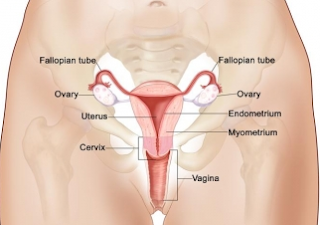 |
| Illustration of symptoms cervical cancer |
This information titled (Cervical Cancer - Cervical, Understanding, Papers, Characteristics, Articles, Signs Causes, Symptoms). Read to about uterus cancer here.
Cervical cancer is really a gynecologic cancer that normally grows outwards and inwards causing cervical enlargement (Derek, 2002: 68). Cervical cancer (cervical) is often a metastatic tumor that grows in the cervix or cervical cancer symptoms uterus or cervix (the best section of the uterus is coupled to the the surface of the vagina) (Susternada, 2007).
Understanding Cancer in the cervix (cervical) is usually a cancer occurring inside uterine cervix, a space where the female sex organ will be the entrance on the uterus located between womb (uterus) with a hole intercourse (vaginal) (John R, 1999).
Reason behind Cervical Cancer - Cervical
The explanation for cervical cancer has until now not known surely, but there are various factors that influence the occurrence of cervical cancer :
1. HPV (human papillomavirus)
Would be the virus that causes warts genetal region (condyloma acuminata) is usually a sexually transmitted cancer Rahim Alternative healthcare. HPV is normally suspected because reason behind the abnormal changes of cervical cells. (Susternada, 2007)
2. Smoker
Content of tobacco that may be within the output of cigarettes, damaging the body's defence mechanism or affect your body's capability to fight HPV infection in the cervix.
3. Pill
This article of estrogen in birth prevention pills can lead to cervical cancer. (Susternada, 2007)
4. Married or initiate sex at the young age (below 16 yrs . old)
Generally new mucosal cells mature after women aged two decades and over. So, a woman who had sex very young, essentially the most vulnerable when it is done in the age of under 16 years. When it reaches this age, the mucosal cells within the immature female cervix. That may be, remains to be subject to stimuli that aren't wanting to receive stimuli externally. Including chemicals that carry sperm. Since it is still vulnerable, mucosal cells turns into cancer properties. While properties of the cell is always changing every moment, die and grow again. Because there may be stimulation of cells grow in excess of dead cells, so the changes usually are not balanced. The surplus cells could eventually get a new nature of the cancer cell. (Erik T, 2005)
5. Multiple sexual partners (promiscuity)
Reason behind cervical cancer, mostly from environmental conditions mediated from the HPV virus. The herpes simplex virus is transmitted through sexual contact. A lady may be who have contracted genital herpes infection using their sexual partners. This viral infection can be spread quickly through intercourse multi partner. Therefore, the condition is usually termed as sexually transmitted disease. And resikoterjadinya cervical cancer increased by over 10X when 6 or higher sex partners. (Erik T, 2005)
6. Delivered many children (multiparity) (Erik T, 2005: 17-20)
7. Quantity of births with short distances
In females who labor (childbirth) is undoubtedly part of the female genital organ is really a birth canal be easily confronted with the outside world, several things happen over the birth process unconsciously virus allowing the infection can enter. Because of these infections can cause changes in cervical mucous cells (dysplasia) (Prawiroharjo, 1999). Exactly like on parity, delivery too close, may cause destruction of the cells from the cervix. Distance delivery could be a risk factor for maternal health when pregnancy at a distance of less than 2 years (DEPKES.RI, 2002)
8. Poor vaginal hygiene
Lower socioeconomic greatly affect ones role in getting knowledge. They cannot be aware that less keep your pubic area can lead to cancer in the cervix, vagina really should be cleaned just after intercourse. (Derek, 2001)
9. Cervical injury who would not receive appropriate treatment (Derek, 2001: 68)
10. A lady whose husband seriously isn't circumcised (circumcision), as the penis neck produced a substance called smegma. At smegma will there be a virus that likes which is easy to breed the Human Papilloma Virus (HPV). HPV features a carcinogen properties, which can be in a position to customize the properties from the cell right into a malignant or cancerous cells.
11. Lower socioeconomic groups
Lower socioeconomic groups sometimes appears from other work, if they are laborers or as prostitutes (from the HPV virus), or from higher socioeconomic. Several recent surveys estimate the incidence of cancer is increasing due to influence of lifestyle.
12. Lack of folic acid (folacin), ascorbic acid, vitamin E, betacarotin / retinol regarding a greater risk of cervical cancer. (School of Medicine, 2002: 101-102)
Cervical Cancer - Munculpada symptoms Cervical Cancer (Neck rahirm)
Whitish are difficult to heal and with the smell. Sap that is released with the vagina will be the longer it's going to smell foul caused by infection and tissue necrosis. (School of Medicine, 2000: 399). Abnormal vaginal bleeding, especially between 2 periods, after sexual activity and after menopause. Abnormal menstruation (longer and much more (Susternada, 2007). Bleeding after menopause (Grace, 2007). Warning signs of advanced cervical cancer :
- Decreased appetite, fat loss, fatigue
- Low back pain, hip and leg
- Urine out of your vagina
In its early stages, cervical cancer typically does not cause symptoms. It may be detected on Pap screening and subsequent testing even before symptoms have developed. When symptoms do occur, one of the most common symptoms is abnormal vaginal bleeding. This can include bleeding between menstrual periods, bleeding after sexual intercourse or a pelvic exam, or bleeding after douching. Unusually heavy menstrual bleeding and bleeding after menopause are also possible symptoms of cervical cancer.
ReplyDelete